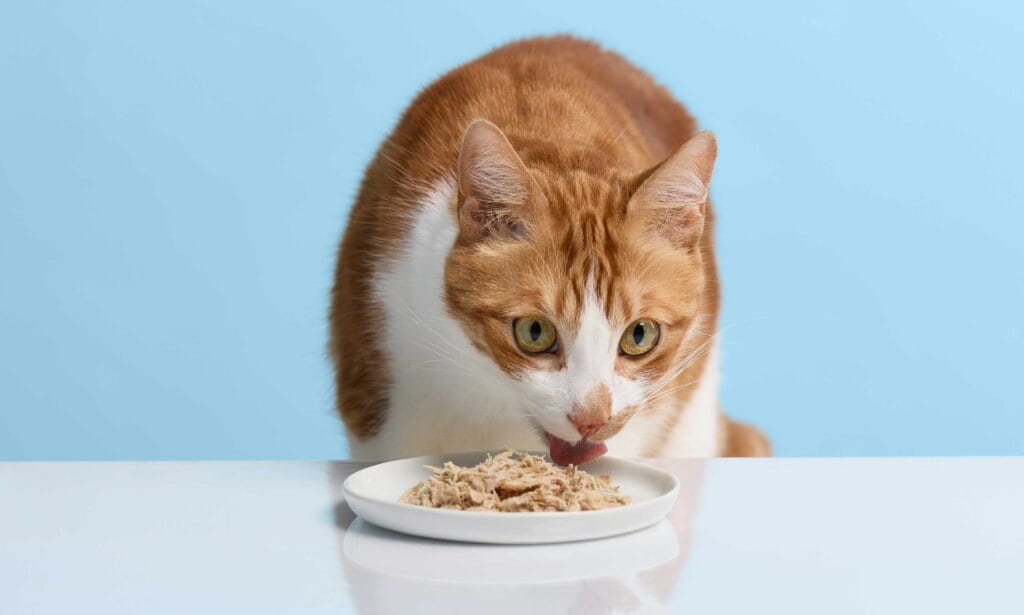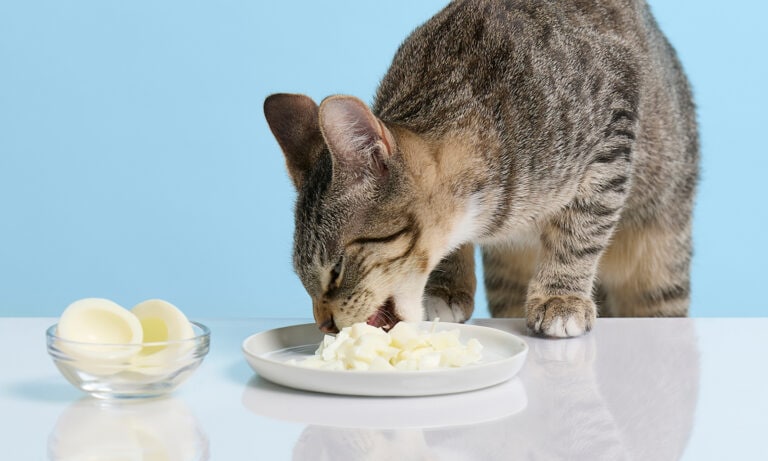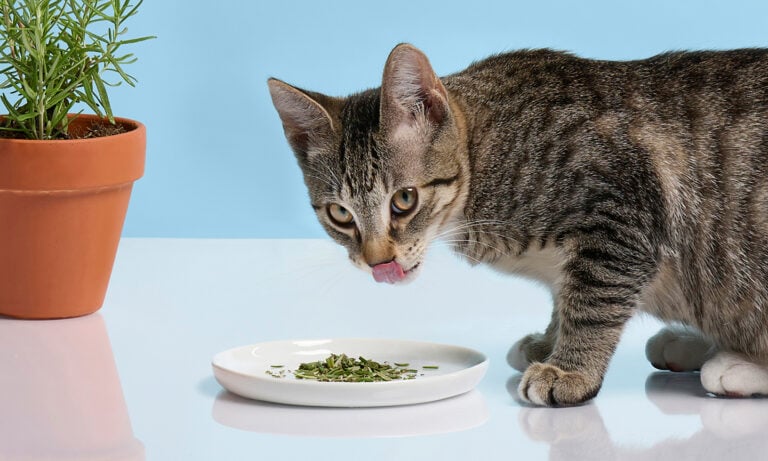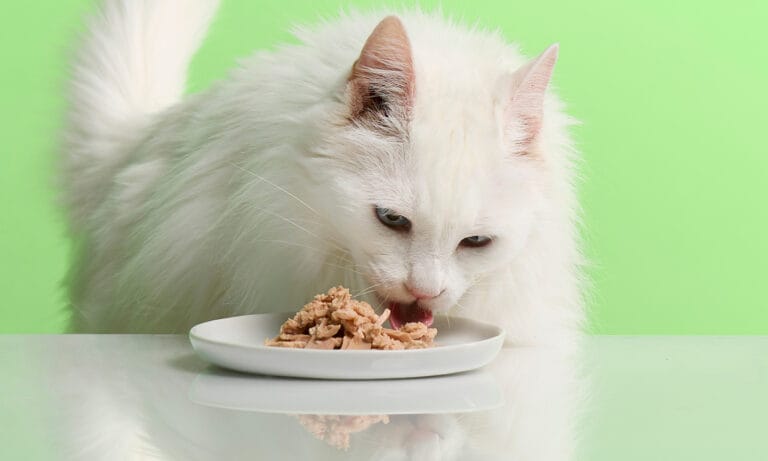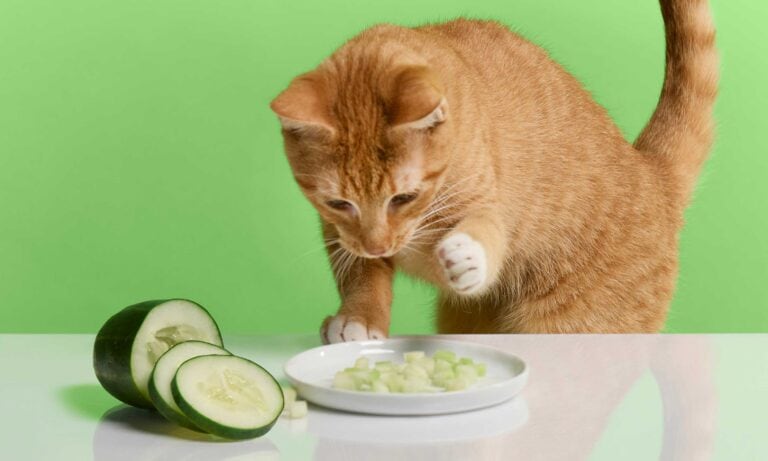As you savor a succulent pork chop, the inquisitive eyes of your feline companion might make you wonder, “Can cats eat pork?”
The answer depends on the type of pork and its preparation. Plain, lean, thoroughly cooked pork is generally safe for cats in small amounts. However, you should not give your cat processed pork (like bacon or ham) or any type of pork that’s seasoned or smothered in sauce. (Unless you want to whip up a batch of this cat-friendly, vet-approved BBQ sauce to lightly slather on some pork as a special treat!)
We spoke to a vet expert to understand the dos and don’ts of offering pork to your purring pal.
Click to jump to each section:
How Much Pork Can I Give My Cat? And How Often?
When treating your cat to a taste of pork, the pork should be:
- Lean: Always stick to lean cuts of pork (like tenderloin or loin chops). Eating a large amount of fatty pork can lead to digestive issues and pancreatitis.
- Fully cooked and unseasoned: The pork should be free of salt, onion, garlic, spices, sauces or marinades.
For most cats, 1-3 small pieces (roughly the size of a pea or two) is sufficient for a treat.
As for frequency, offering pork as a treat once a week or less is recommended.
A general rule of thumb when giving your cat treats or human food, including pork, is the 10 percent rule: No more than 10 percent of your cat’s daily calories should come from these items. The other 90 percent should come from well-balanced cat food.
5 Ways to Safely Treat Your Cat to Pork
Treating your beloved feline to the rich flavor of pork requires a blend of creativity and safety.
Here are some ideas for offering your furry friend this tasty indulgence.
1Keep It Simple
If you want to keep things simple, plain, cooked pork is the way to go.
To prepare the pork, follow these steps:
- Boil plain loin chops or tenderloin in water until thoroughly cooked (about 30 minutes). Do not add oil, seasonings, spices or sauces.
- Cut the cooked pork into small, pea-size pieces, and treat your cat to a small piece or two.
- Save leftovers in the fridge (up to three days) and/or freezer for later use.
2Make Porky Pops
Looking for a tasty treat for your kitty on those hot summer days? Whip up a batch of porky pops! Here’s how to make them:
- Cut plain, lean, cooked pork into tiny bits.
- Get an ice cube tray and put two to three small bits of pork in each ice cube slot.
- Pour a cat-friendly broth (like Caru Bone Broth) over the pork, filling the ice cube slots to the top.
- Place in the freezer until the broth is frozen.
- As an occasional treat, remove an ice cube from the tray and give it to your cat to lick.
As the ice melts, your cat will be rewarded with the bits of pork. Just be sure to monitor your cat with the ice cube, taking away pieces they could choke on.
3Make Baked Pork Bites
Looking for a crunchy treat your cats will go crazy for? Try making baked pork bites. Here’s how:
- Set your oven to 350°F.
- Cut lean, plain pork into pea-size pieces.
- Place the pieces on a parchment-lined baking sheet.
- Bake in the oven until thoroughly cooked and crispy (about 35 minutes).
- Store in the refrigerator for two weeks or freeze for months.
4Seek Out Commercial Cat Food with Pork
There are several high-quality cat foods on the market that include pork as a primary ingredient. If your chosen brand offers pork as a flavor option, follow the feeding guidelines on the packaging.
Here are a few good options:
5Offer Pork-Based Cat Treats
For those who prefer the convenience of store-bought cat treats, here are some good pork-based options to try:
Benefits of Pork for Your Cat
When fed appropriately, pork can offer your kitty a variety of benefits.
Here’s why adding this meat to your cat’s diet, either through treats or their primary food, can be advantageous:
- It offers high-quality protein: As obligate carnivores, cats require a diet high in animal protein. Pork is an excellent source of protein, offering essential amino acids like taurine and arginine. Protein supports various bodily functions, including muscle growth, tissue repair, and the production of enzymes and hormones.
- Provides essential vitamins and minerals: Pork is a good source of several essential nutrients, including B vitamins (especially B6 and B12), which aid in metabolic processes, energy production and the formation of red blood cells. Pork also offers essential minerals, like phosphorus (important for bone health) and zinc (supports a strong immune system).
- Has an enticing flavor: Many cats find pork delicious. Introducing pork can add variety to your cat’s diet and entice picky eaters.
- It makes for a high-value treat: Cats can be motivated by treats to follow commands or practice new behaviors. A delectable morsel of pork might be just the incentive your kitty needs to perfect that new trick or to reinforce a positive behavior.
Risks of Giving Your Cat Pork
While pork can offer some benefits when given as an occasional treat, there are also risks cat owners should be aware of.
Here are some potential hazards associated with feeding pork to your feline:
- Parasitic infections: Undercooked or raw pork can harbor parasites that are harmful to cats. A notable one is roundworm, or Trichinella spiralis, which can lead to trichinosis. This condition can result in digestive disturbances, muscle inflammation and fever. To avoid this risk, ensure pork is always thoroughly cooked. One exception is store-bought raw cat food, like Primal Pork Nuggets, which uses high-pressure processing to kill harmful microbes.
- Bone hazards: Pork bones, especially once cooked, can splinter easily. These fragments pose a choking hazard and can cause a blockage in a cat’s digestive tract. Always remove any bones before serving your cat pork.
- Toxic ingredients: Pork prepared for humans is typically seasoned with onion powder, garlic powder or other spices. Such seasonings can be toxic to cats. Onions and garlic, for example, can cause anemia. Also, processed pork, such as ham and bacon, often contains preservatives like sodium nitrites that can be toxic to cats in large quantities.
- Salt intake: Processed or pre-seasoned pork products are usually high in salt. An elevated salt intake can cause increased thirst and urination in cats. In more severe instances, excessive salt can lead to salt poisoning.
- Obesity risk: While an occasional treat is OK, regularly feeding your cat pork, particularly the fattier cuts, can lead to weight gain. Obesity can increase the risk of several health issues, including joint problems, diabetes and heart disease. Get tips for helping overweight felines.
FAQs About Pork and Cats
Q:
Can cats eat cooked pork?
Q:
What happens if cats eat pork?
Q:
Can cats eat pork rinds?
Q:
What meat should cats not eat?
More foods cats can eat:
Share:
